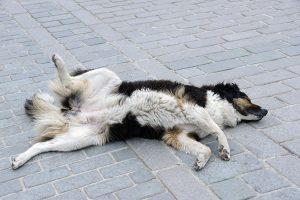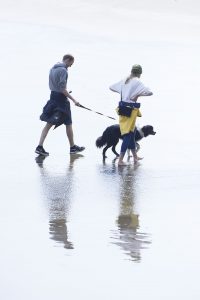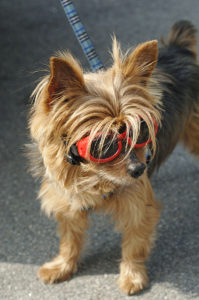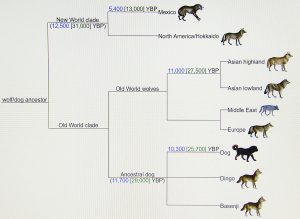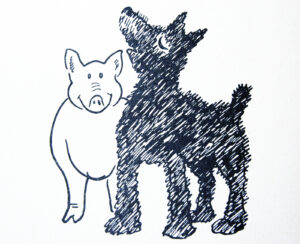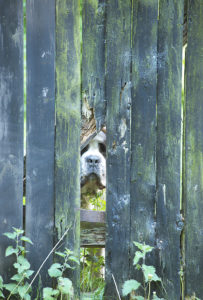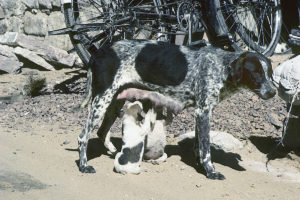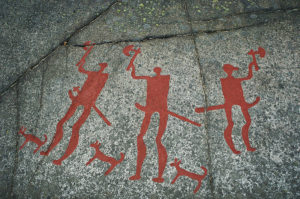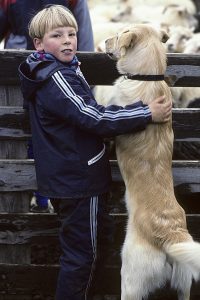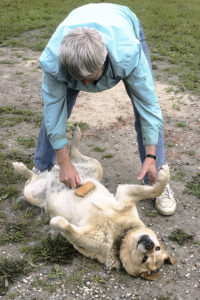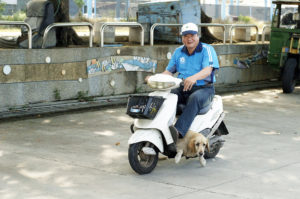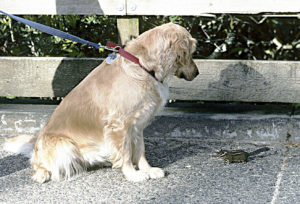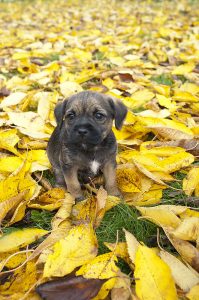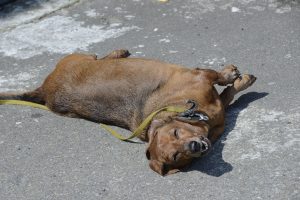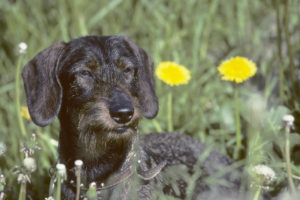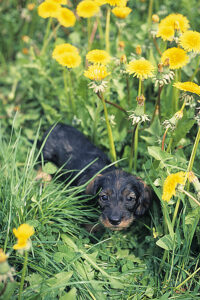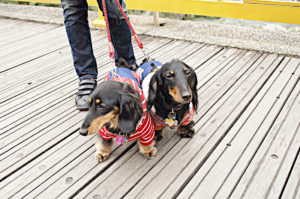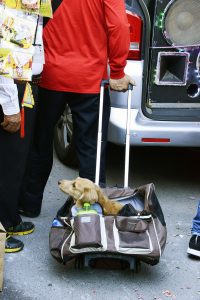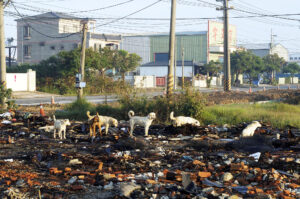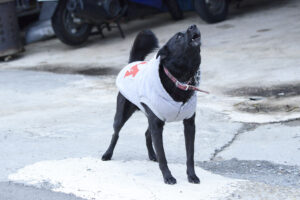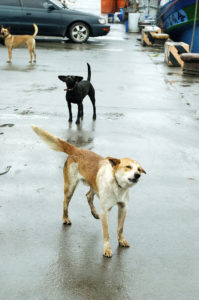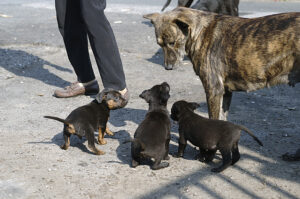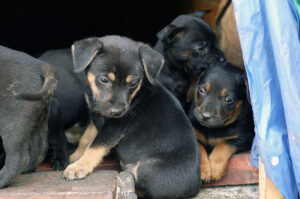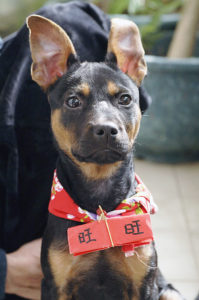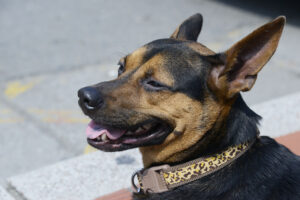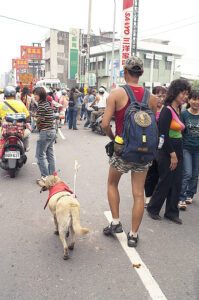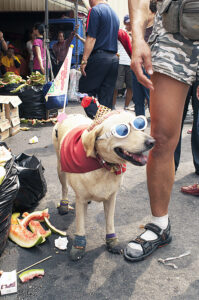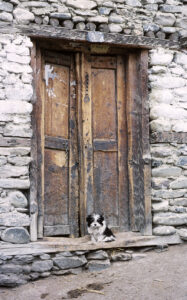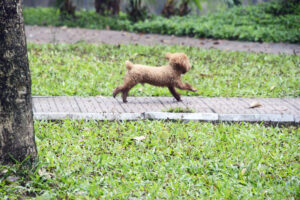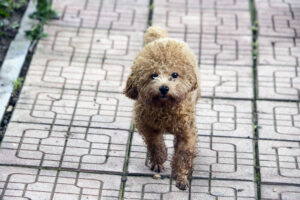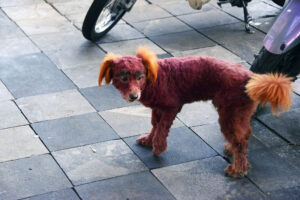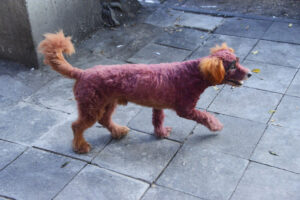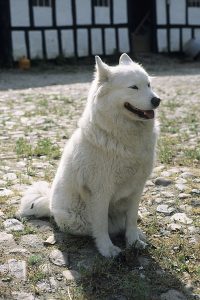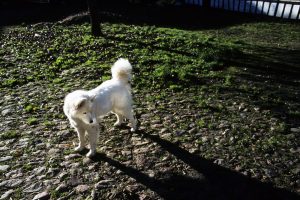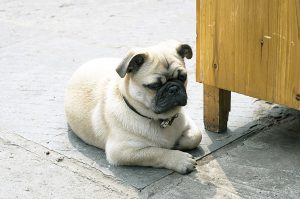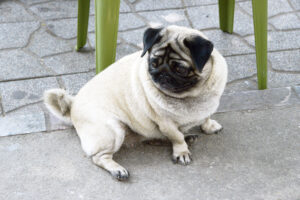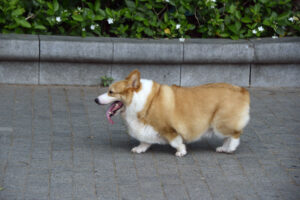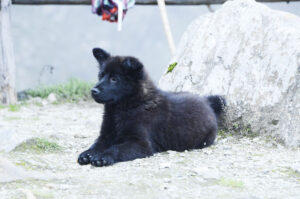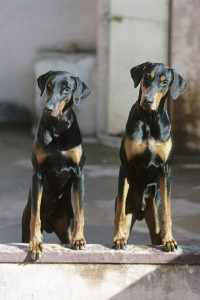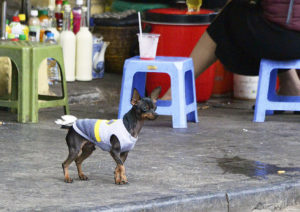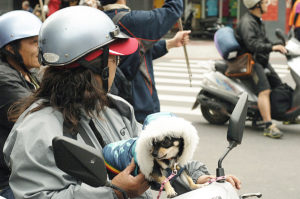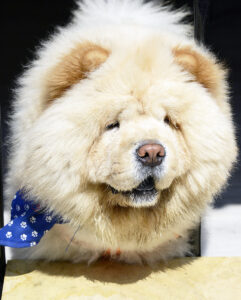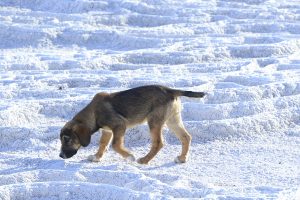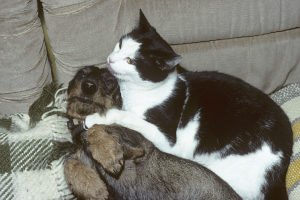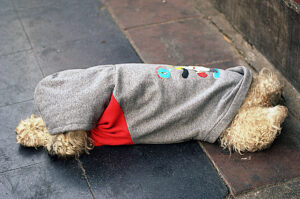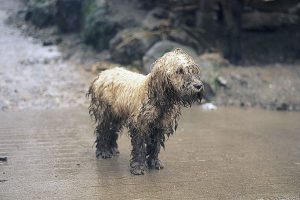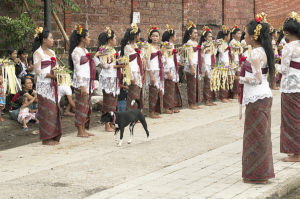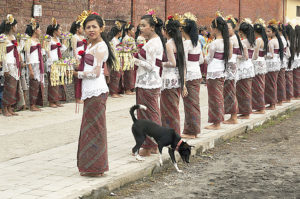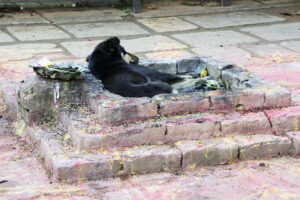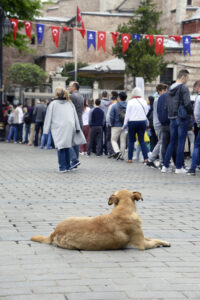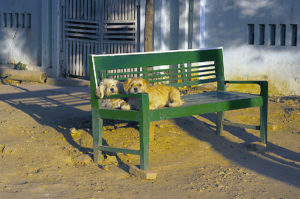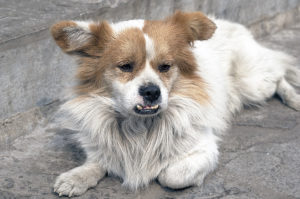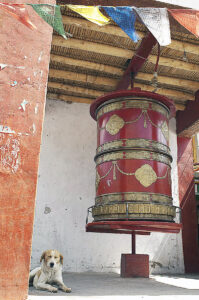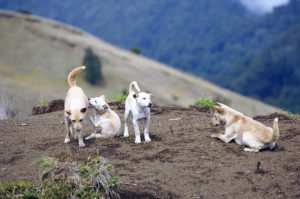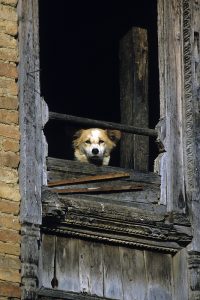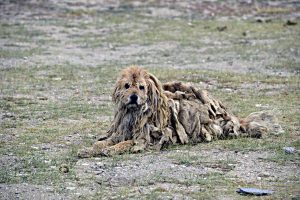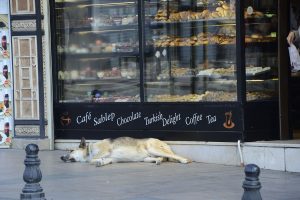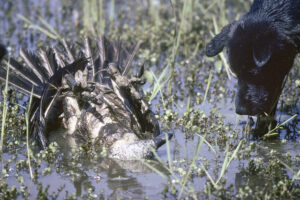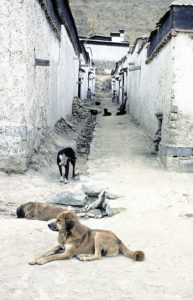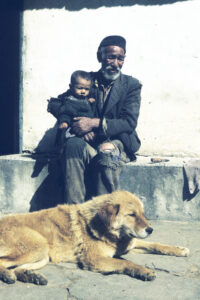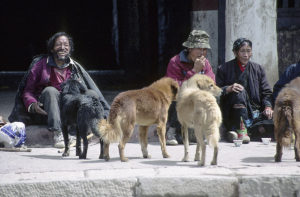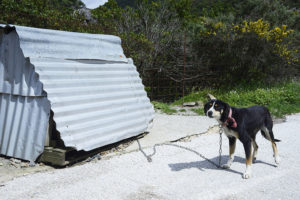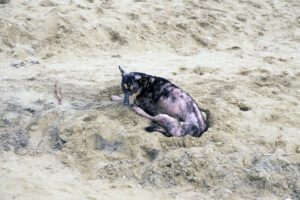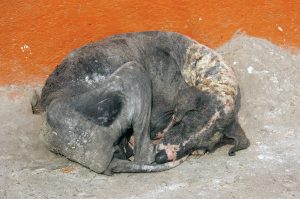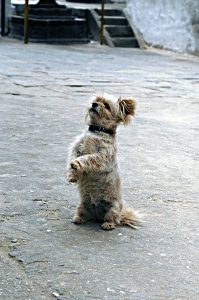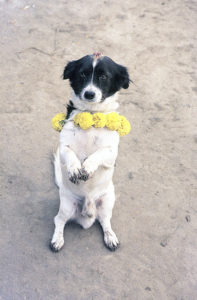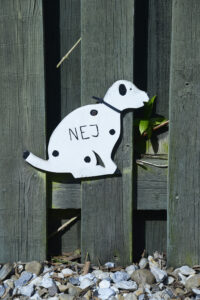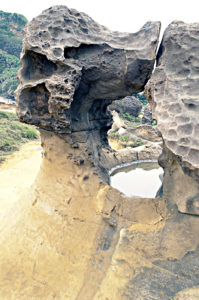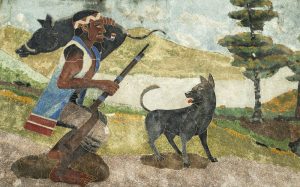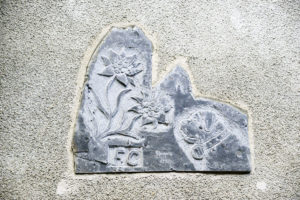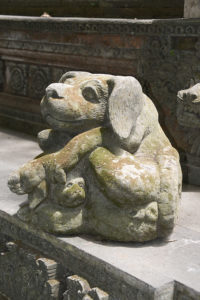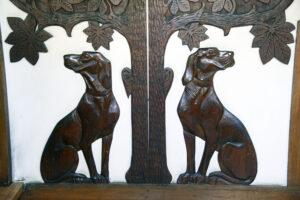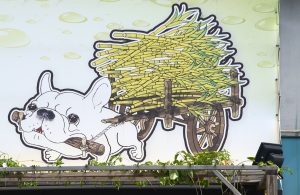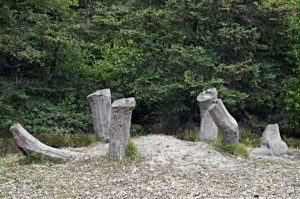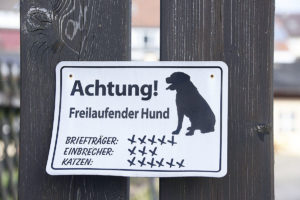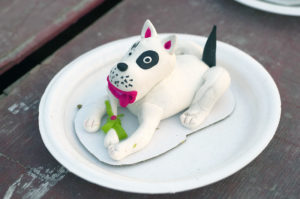Dog
The art of relaxation! – Istanbul, Turkey. (Photo copyright © by Kaj Halberg)
Walking the dog, Muriwai Beach, New Zealand. (Photo copyright © by Kaj Halberg)
Accompanied by her pup, this young Gurung woman supplies her income by selling apples to tourists, who pass through her village in the Marsyangdi Valley, Annapurna, central Nepal. (Photo copyright © by Kaj Halberg)
I asked the owner of this little terrier in Taichung, Taiwan, why it was wearing sunglasses. She said that it was to prevent the dog from getting cataract. (Photo copyright © by Kaj Halberg)
The origin of the domestic dog is a complicated matter. DNA evidence indicates that the dog (Canis lupus familiaris), the modern grey wolf (C. l. lupus), as well as the now extinct Taimyr wolf (C. l. cf. lupus), all diverged from a now extinct wolf that once lived in Europe. The dog and the present grey wolf form two sister clades, and modern wolves are not very closely related to the wolves that were first domesticated.
Domestication of wolves
According to some archaeologists, the first burial of dogs along with humans took place c. 14,700 years ago, while others maintain that it took place long before that, namely c. 36,000 years ago. Under all circumstances, the archaeological evidence shows that the wolves, which were domesticated by hunter-gatherers, were the first domesticated animal species of all.
This domestication took place at different localities simultaneously, probably in Western Europe, Central Asia, and East Asia. New genetic research points out that an initial wolf population split into East and West Eurasian groups, both of which, before going extinct, were domesticated independently into two distinct dog populations, between 14,000 and 6,400 years ago. The Western Eurasian dog population was partially replaced by East Asian dogs, introduced by humans at least 6,400 years ago. (A list of sources may be seen at en.wikipedia.org/wiki/Origin_of_the_domestic_dog).
Two types of dogs, which descended from the ancestral dog, are so different from other dogs that they have been given subspecific status: the Australian Dingo (C. l. dingo) and the African Basenji (C. l. basenji). They differ from other dogs in that they cannot bark, and they come into oestrus only once a year, as opposed to twice or more annually in other dogs. They also both lack a distinctive body odour.
Genetic evidence indicates that the Dingo originated from East Asian domestic dogs. It was introduced to Australia about 4,000 years ago by seafaring tribes, and today feral populations live in most of the continent, barred from access to the south-eastern part of the country by a so-called ‘dingo fence’. Today, it is the largest terrestrial predator in Australia, as the indigenous thylacine, or Tasmanian wolf (Thylacinus cynocephalus), was extirpated by farmers in the 1900s. Dingos are often a threat to livestock, but at the same time they benefit farmers, as they mainly prey on rabbits, kangaroos, and rats – three major pests in Australian farming.
The Basenji is said to have originated in the Congo Basin in West Africa. Dogs, resembling modern Basenjis are depicted in Egyptian tombs, sitting with pricked ears and tightly curled tails, just as they do today. Dogs of this type were originally kept in Egypt for hunting small game (Dollman 1937).
Through their long relationship with humans, dogs have become uniquely attuned to human behaviour, and they are able to thrive on a starch-rich diet that would be inadequate for wild members of the dog family. At least 200 dog breeds are known, varying immensely in size, shape, and colours, from the 300-pound English mastiff to the Chihuahua, which weighs only 1-2 kilograms. Dogs are utilized in countless activities, ranging from companionship and protection to hunting, herding, racing, pulling sledges, rescuing, assisting police and customs, and aiding handicapped people, to mention but a few. No wonder, the dog has been given the sobriquet ‘man’s best friend’.
Other pictures, depicting domestic dogs as well as other members of the dog family, are shown on the page Animals – Mammals: Dog family.
Phylogenetic tree of extant grey wolf populations, with divergence times calculated, using an assumed mutation rate of Lindblad-Toh (2005) (1×10−8, shown in blue), and Skoglund (2015) (0.4×10−8, shown in green, in brackets). (Illustration borrowed from en.wikipedia.org/wiki/Origin_of_the_domestic_dog)
The dog’s sense of smell
The dog’s world is a world of smells that humans are in no precondition to understand at all. Their fantastic sense of smell makes them able to follow the route of a person that has merely walked through an area. The huge Saint Bernard dog is a famous breed, which originated in the western part of the Alps around the Great and Little St. Bernard Passes, where it was utilized to rescue people in need of help. Sometimes it is able to smell people who are buried under several feet of snow in avalanches.
This lengendaric sense of smell inspired English author Hugh Lofting (1886-1947), when he wrote his delightful children’s book The Story of Doctor Dolittle, Being the History of His Peculiar Life at Home and Astonishing Adventures in Foreign Parts (1920). One chapter deals with the dog Jip trying to find a little boy’s uncle who has been abducted by pirates who stole his ship and set him ashore on a rocky islet. Jip smells the wind from the north, mumbling to himself:
“Tar; Spanish onions; kerosene oil; wet raincoats; crushed laurel-leaves; rubber burning; lace-curtains being washed. No, my mistake, lace-curtains hanging out to dry; and foxes – hundreds of ’em – cubs; and –”
“Can you really smell all those different things in this one wind?” asked the Doctor.
“Why, of course!” said Jip. “And those are only a few of the easy smells – the strong ones. Any mongrel could smell those with a cold in the head. Wait now, and I’ll tell you some of the harder scents that are coming on this wind – a few of the dainty ones.”
Then the dog shut his eyes tight, poked his nose straight up in the air and sniffed hard with his mouth half-open.
(…)
“Bricks,” he whispered, very low, “old yellow bricks, crumbling with age in a garden-wall; the sweet breath of young cows standing in a mountain-stream; the lead roof of a dove-cote – or perhaps a granary – with the mid-day sun on it; black kid gloves lying in a bureau-drawer of walnut-wood; a dusty road with a horses’ drinking-trough beneath the sycamores; little mushrooms bursting through the rotting leaves; and – and –”
Jip, identifying smells, overseen by the pig Gub-Gub. Illustration by Danish artist Robert Storm Petersen (1882-1949) in the Danish edition of Doctor Dolittle (1954). (Public domain)
Saint Bernard dog, sniffing through a gap in a hoarding, Bornholm, Denmark. (Photo copyright © by Kaj Halberg)
Gestation period
The gestation period of dogs varies between 58 and 68 days, depending on size. Humans often begin to wean pups, when they are ca. 8 weeks old, but if their mother allows them, pups will suckle much longer.
Stray dog, suckling her pups, Jodhpur, Rajasthan, India. (Photo copyright © by Kaj Halberg)
Hunting dogs
Neolithic people domesticated wolves to assist them when hunting, and possibly also during warfare. Since then, many dog breeds have been developed, especially as hunting dogs.
This Bronze Age petroglyph at Fossum, Bohuslän, Sweden, may depict men in battle, accompanied by dogs. (Photo copyright © by Kaj Halberg)
The English Springer Spaniel is a hunting dog breed, descended from Norfolk or Shropshire Spaniels in the mid-1800s. It was traditionally used for flushing out game, and for retrieving it. Today, it is also a popular family dog.
During a research trip to the Chukotka Peninsula, north-eastern Siberia, my companions and I visited the staff of a light house, situated at the tip of Kosa Ruskaya Koshka (‘Russian Cat’s Sandspit’). One of the dogs belonging to the staff was an English springer spaniel. Our trip to this area is related in detail on the page Travel episodes – Siberia 2011: Caterpillar trip in Chukotka.
This English Springer Spaniel, which belongs to the staff of the Kosa Ruskaya lighthouse, goes exploring in the surrounding wetlands. (Photo copyright © by Kaj Halberg)
Another hunting dog breed is the Golden Retriever, which was originally bred in Scotland in the mid-1800s to retrieve ducks and game birds, which were shot during hunting parties. It was called retriever due to its excellent ability to retrieve shot birds, which were undamaged because of the soft mouth of this breed. Today, due to its gentle demeanour, the Golden Retriever is a very popular family pet.
This boy and his Golden Retriever are watching rounding-up of sheep, near Akureyri, Iceland. (Photo copyright © by Kaj Halberg)
It is obvious that this Golden Retriever enjoys being groomed on its stomach. – Denmark. (Photo copyright © by Kaj Halberg)
This Golden Retriever is too old (and too overweight) to run after his master’s scooter, so the owner transports it in this way. – Fangliao, Taiwan. (Photo copyright © by Kaj Halberg)
For a long time, this Golden Retriever, encountered in Reedsport, Oregon, was watching a confiding Townsend’s chipmunk (Neotamias townsendii), later sniffing it without harming it. – Chipmunks and many other squirrels are described on the page Animals – Mammals: Squirrels. (Photo copyright © by Kaj Halberg)
The small Border terrier was bred to accompany fox hunters on horseback. It was big enough to keep up with the horses and small enough to enter burrows of foxes and chase them out for the hunters to shoot. The foxhounds, which also accompanied the hunters, were too large to enter fox dens.
Border terriers, adult and pup, surrounded by fallen leaves of sweet cherry (Prunus avium), Funen, Denmark. (Photos copyright © by Kaj Halberg)
The short-legged dachshund was also bred to chase foxes and badgers out of their dens, and in America it has been used to chase prairie dogs out of their burrows. This breed comes in three forms: smooth-coated, wire-haired, and long-haired.
This smooth-coated dachshund, resting on a sidewalk in the city of Taichung, Taiwan, is so lazy that it doesn’t even bother to raise its head when barking at me. (Photo copyright © by Kaj Halberg)
Wire-haired dachshund, resting among dandelions (Taraxacum officinale), Denmark. (Photo copyright © by Kaj Halberg)
Sleeping wire-haired dachshund pups, 3 weeks old, Denmark. (Photos copyright © by Kaj Halberg)
This wire-haired dachshund pup goes exploring among dandelions, Denmark. (Photo copyright © by Kaj Halberg)
These long-haired dachshunds are warmly dressed as a protection against the Taiwanese ‘winter cold’. The temperature was around 20 degrees Centigrade! – Taroko National Park. (Photo copyright © by Kaj Halberg)
Transporting a long-haired dachshund through a dense crowd of people, gathered in front of the Daoist temple Bai Sa Wan Mazu, near Tongxiao, western Taiwan. (Photo copyright © by Kaj Halberg)
This long-haired dachshund is being transported in a cardboard box on the back of a scooter, Siao Liouchou Island, Taiwan. (Photo copyright © by Kaj Halberg)
The Formosan hunting dog originated in Taiwan, where it would accompany indigenous Malayan tribals on their hunting trips. Later, other peoples migrated to Taiwan from China and Japan, bringing other dog races with them, and today’s stray dogs on the island, called Taiwan dogs or Takasago dogs, are a result of the Formosan hunting dog interbreeding with these imported dog breeds. Today, most Taiwan dogs are black or brown, or a mixture of the two, but cream-coloured and yellowish-brown dogs are also seen, besides brindled individuals, which have more genes from the Formosan hunting dog.
The pattern on the coat of this brindled Taiwan dog, observed in Sheding Nature Park, Kenting National Park, indicates that it has many Formosan hunting dog genes. (Photo copyright © by Kaj Halberg)
Many Taiwan dogs are stray dogs, which roam the cities in search of food, like these in a garbage dump in Linyuan, a suburb of Kaohsiung. As Buddhists, many people feel that it is a good deed to feed these dogs, but the truth of the matter is that there are far to many stray dogs in Taiwan, littering the streets with their excreta, which may spread disease. (Photo copyright © by Kaj Halberg)
Resting Taiwan dogs of a pale type, Yeliou Geopark, northern Taiwan (top), and Nanhua Ecological Park, near Yujing, southern Taiwan. (Photos copyright © by Kaj Halberg)
Despite barking ferociously at me, these Taiwan dogs in Taichung (top), and in Wushe Fishing Harbour, eastern Taiwan, show a friendly attitude by wagging their tail. (Photos copyright © by Kaj Halberg)
Taiwan pups, about four weeks old. The bitch seems to have many genes from the Formosan hunting dog. (Photos copyright © by Kaj Halberg)
During Chinese New Year, a red scarf has been tied around the neck of this 12-week-old Taiwan pup. A red envelope, on which is written Wang-wang, is fastened to it. The red colour of the envelope, as well as the text, denotes well-wishing. Wang-wang is also an imitation of a dog’s barking. (Photo copyright © by Kaj Halberg)
Same dog as in the picture above, 3 years later. (Photo copyright © by Kaj Halberg)
Other dog breeds
Initially, the Labrador Retriever was bred as a working dog, assisting fishermen in Labrador to haul nets, fetch ropes, and retrieve fish from the chilly North Atlantic. Today, it is a popular family dog.
In the pictures below, a Labrador Retriever is accompanying his master on a pilgrimage hike during a Taiwanese Daoist festival, dedicated to the Mother Goddess Mazu. During this festival, pilgrims often walk for days, spending the night in temples on the way. Both man and dog are well equipped for the journey.
Other Daoist festivals, as well as the origin of Daoism, are described on the page Religion: Daoism in Taiwan.
(Photos copyright © by Kaj Halberg)
Despite its name, the Tibetan Terrier is not a real terrier. The name originated from European travelers, to whom it resembled terrier breeds. The Tibetan name for this dog is Tsang Apso, which translates as ‘the bearded (or shaggy) one from (the province of) Tsang’. According to Tibetan sources, this breed evolved more than 2,000 years ago. Tibetan Terriers were kept as companions, good luck mascots, watchdogs, and herding dogs, and they were also trained to retrieve smaller items that had fallen down mountain sides. (Source: Tibetan Terrier Club of America, ttca-online.org/html/history)
Following heavy rain, this Tibetan Terrier in the village of Peokar, near Keylong, Lahaul, Himachal Pradesh, India, has become rather muddy. (Photo copyright © by Kaj Halberg)
This Tibetan Terrier pup is guarding outside the entrance to a house in the village of Braga, Marsyangdi Valley, Annapurna, central Nepal. (Photo copyright © by Kaj Halberg)
The Poodle likely originated in Germany during the Middle Ages. It was the German ‘water dog’, originally used by wildfowl hunters to retrieve ducks that fell into the water. The name Pudel is of Germanic origin, derived from the old German word puddeln, meaning ‘to splash’. German art work from as early as the 17th Century depict Poodle-like dogs.
Several types of Poodles have evolved, including various colour forms, and dwarf forms which were previously much used as circus performers. Poodles are common at dog shows, where face and rear parts are clipped close, with tufts of hair on the hocks and tail tip.
This brown dwarf poodle was running around in Hanoi Botanical Gardens, Vietnam. (Photos copyright © by Kaj Halberg)
This trimmed poodle in Hanoi has been dyed reddish-violet, with orange ears, tail, and feet. (Photos copyright © by Kaj Halberg)
The Samoyed originated among the nomadic Samoyed people in Siberia, to pull sledges and to assist in the herding of reindeer. Today, it is a very popular family dog in the West.
Samoyed, Jutland, Denmark. In the lower picture, it is watching its own shadow. (Photos copyright © by Kaj Halberg)
The Chinese pug is known to be a sociable and loving companion dog. As its name implies, it was developed in China, but arrived in Europe as early as the 16th Century.
Chinese pug, Guiyang, Guizhou Province, China. (Photo copyright © by Kaj Halberg)
Many dog owners overfeed their dogs. This Chinese pug was observed in Hanoi, Vietnam. (Photo copyright © by Kaj Halberg)
The Pembroke Welsh Corgi originated in Pembrokeshire, Wales, and was originally a cattle herding dog.
This overweight Pembroke Welsh Corgi was also observed in Hanoi. (Photo copyright © by Kaj Halberg)
The huge Tibetan mastiff was developed by Tibetan herders to protect their sheep and goats from being attacked by various predators, such as snow leopards and wolves.
Tibetan mastiff, guarding outside a road-side restaurant, Trisuli Valley, central Nepal. (Photo copyright © by Kaj Halberg)
Tibetan mastiff pup, Phedi, Langtang National Park, Nepal. (Photo copyright © by Kaj Halberg)
The Doberman pinscher originated in Germany, developed around 1890. If well trained, they can become loving family dogs, but on the other hand, there has been a number of incidents, in which Dobermans were mauling children.
Doberman pinschers, about one year old, Mysore, Karnataka, India. (Photo copyright © by Kaj Halberg)
As its name implies, the Miniature Pinscher is small, resembling a very small edition of the Doberman. This breed, which originated from Germany, was the result of cross-breeding a number of breeds, including the German Pinscher, the Italian greyhound, and the dachshund.
In East Asia, when the temperature gets below 20o Centigrade, people dress themselves (and their dogs) in warm clothes as a protection against the ‘winter cold’. These pictures show Miniature Pinschers, photographed in Hanoi, Vietnam (top), and in Taitung, Taiwan. (Photos copyright © by Kaj Halberg)
The Chow-Chow evolved in northern China, or perhaps Central Asia, around 2,000 years ago. In Chinese, it is called 鬆獅犬, which means ‘puffy lion-dog’. This breed is famous for its blue tongue.
Chow-Chow, Lugang, Taiwan. (Photo copyright © by Kaj Halberg)
Other pictures of dogs
At Pamukkale, western Turkey, water, containing dissolved calcium bicarbonate, is running down a slope over a wide area, where the mineral is deposited, and, over millennia, has formed numerous bluish-white terraces, some dry, some containing ponds with shallow water. Pictures, depicting these gorgeous terraces, may be seen on the page Nature: Nature’s patterns.
This pup goes exploring, sniffing about on the Pamukkale terraces. (Photo copyright © by Kaj Halberg)
Usually, dogs and cats are sworn enemies, but if they grow up together, like this cat and wire-haired dachshund, they can be the best of friends. (Photo copyright © by Kaj Halberg)
Well-dressed dog, sleeping on a sidewalk, Bangkok, Thailand. I don’t know what its owner has been thinking, because the temperature was around 30o Centigrade! The snout is just protruding to the left. (Photo copyright © by Kaj Halberg)
In the wake of the deadly 1998-hurricane ‘Mitch’, huge amounts of rain fell in Central America between October 29 and November 3 – unofficial reports say 1,900 mm.
This drenched dog, smeared in mud, was photographed during the hurricane ‘Mitch’, in the town of Todos Santos, Guatemala. (Photo copyright © by Kaj Halberg)
These girls, dressed in their finery for a dancing performance at a Hindu temple festival near Ubud, Bali, Indonesia, are being thoroughly inspected by a dog. (Photos copyright © by Kaj Halberg)
This dog is sleeping in the ashes of burned offerings at the Hindu Manakamana Kali Temple, central Nepal. (Photo copyright © by Kaj Halberg)
Resting dog, watching people queuing up at the entrance to the church Aya Sofia, Istanbul, Turkey. (Photo copyright © by Kaj Halberg)
These little dogs clearly enjoy the evening sun from a bench, Bagan, Myanmar. (Photo copyright © by Kaj Halberg)
This dog in Guiyang, Guizhou Province, China, may have some Tibetan spaniel genes, and probably also some Pekingese, due to its very prominent lower jaw. (Photo copyright © by Kaj Halberg)
Inside Tibetan Buddhist prayer wheels are sheets of paper with written mantras. When turned, the prayer wheel will disperse these mantras into the Universe, for the benefit of Mankind. – Prayer wheels and other aspects of Buddhism are described in depth on the page Religion: Buddhism.
This dog has found a peaceful resting place, next to a huge Tibetan prayer wheel, Upshi, Ladakh, north-western India. (Photo copyright © by Kaj Halberg)
In Taiwan, in late April or early May, the mu oil tree (Vernicia montana) displays an abundance of pretty white flowers. The slightest puff of wind makes flowers fall from the trees by the hundreds, gradually covering the ground as a delicate white carpet.
A number of pictures, showing the gorgeous flower display of this tree, may be seen on the page Plants: When the mu oil tree is flowering.
These dogs are resting on a delicate white carpet of fallen flowers from the mu oil tree, near Sanyi. (Photo copyright © by Kaj Halberg)
Young dogs, enjoying life on the crater rim of Gunung Rinjani Volcano, Lombok, Indonesia. (Photo copyright © by Kaj Halberg)
Small dog, looking out from a carved wooden window opening, Kathmandu, Nepal. (Photo copyright © by Kaj Halberg)
By September, this herding dog, living near Lake Tso Kar, Ladakh, India, had still not shed its fur from the previous winter, giving it a rather ragged appearance. (Photos copyright © by Kaj Halberg)
Several dogs stayed outside this bakery shop in Sultanahmet, Istanbul, Turkey. This one looks well-fed, so it must have had its share once in a while! (Photo copyright © by Kaj Halberg)
This white-rumped vulture (Gyps bengalensis) was sitting peacefully in a wet fallow field near Pokhara, Nepal, next to the remains of a dead cow, when a dog suddenly attacked it. The vulture rolled onto its back to defend itself with its sharp talons. The dog tore a bit at the vulture’s wingtip, but soon withdrew. The vulture suffered no injuries, and a few moments later it was again resting near the carcass. (Photo copyright © by Kaj Halberg)
Stray dogs are ubiquitous in the city of Shigatse, Tibet. These are resting in an alley. (Photo copyright © by Kaj Halberg)
This woman in the city of Taichung is walking her four small dogs, Taiwanese style. (Photo copyright © by Kaj Halberg)
I was here! – Imprints of a dog’s pads on drying laundry, Ganges River, Varanasi, India. (Photo copyright © by Kaj Halberg)
This huge dog guarantees that nothing evil will happen to this elderly man and his grandchild, living in the village of Lata, Uttarakhand, India. (Photo copyright © by Kaj Halberg)
These dogs hope to get tidbits from pilgrims, who visit the huge Kumbum Stupa in Gyantse, Tibet. This great stupa is presented elsewhere, see Travel episodes – Tibet 1987: Tibetan summer. (Photo copyright © by Kaj Halberg)
In many places, dogs are treated cruelly. This poor dog was chained to a dog house, consisting of corrugated iron sheets, at the road north of Palaiochora, southern Crete. One must hope that the owner does not chain the dog to this house in the summer time, when the temperature inside must be red-hot.
When I knelt down and tried to call the dog, it was utterly delighted and came creeping along the ground, with its tail between the legs. Obviously, it enjoyed being scratched on the head, but when my companion joined us, it immediately got scared and ran as far away, as the chain permitted.
(Photo copyright © by Kaj Halberg)
Sarcoptic mange is a disease among dogs, caused by mites of the species Sarcoptes scabiei, which tunnel through the skin, causing intense itching. The hair loss mainly stems from the dog scratching itself to relieve the irritation.
These pariah dogs in India are almost hairless due to severe attacks of sarcoptic mange. (Photos copyright © by Kaj Halberg)
Many dogs are quite intelligent and can learn many tricks.
Kathmandu, Nepal. (Photo copyright © by Kaj Halberg)
Dipávali, or Tihar, popularly called Festival of Lights, is a very important Hindu festival, which lasts five days. The second day, Kukur Puja, is dedicated to the dog, which plays an important role in Hinduism, as it guides the souls of the deceased to the god of death, Yama, for judgement. In the morning, the family places a red tika mark on the forehead of the dog, and a malla (a garland of marigolds) is draped around its neck. The dog is worshipped with incense, whereupon huge amounts of food are presented to it, before the family itself eat breakfast.
This dog in the village of Sauraha, southern Nepal, has been adorned during the Dipávali festival. (Photo copyright © by Kaj Halberg)
Today, many dog owners around the world bring their dogs to special dog restaurants, or to shops for dog bathing, pedicure, fur cutting etc.
Dog bath and restaurant, Taichung, Taiwan. (Photo copyright © by Kaj Halberg)
In many cities around the world, it is now the law that you must clean up after your dog. For this purpose, plastic bags are often provided.
Here you can collect a plastic bag for your dog’s droppings, Taichung, Taiwan. (Photo copyright © by Kaj Halberg)
Dog shit? No, thank you! – Home-made sign, placed along a walkway next to a houseowner’s garden, Nyborg, Denmark. (Photo copyright © by Kaj Halberg)
Erosion from sea and wind has shaped the soft Daliao Sandstone rocks in Yeliou Geopark, northern Taiwan, creating fantastic formations. More pictures of these formations are presented on the page Nature: Nature’s art.
This formation in Yeliou Geopark has been eroded, so that it resembles a dog sniffing another dog. (Photo copyright © by Kaj Halberg)
Dogs in art
It is no wonder that the dog is often depicted in art, and elsewhere. Below is a selection of pictures, showing various depictions of dogs.
Wall painting in a tribal village near Dongshih, Taichung, depicting a hunter with a Formosan hunting dog and a bagged wild boar (Sus scrofa). It is created by people from the indigenous Atayal tribe Tian Gou (‘Heavenly Dog’). – Other pictures depicting Taiwanese indigenous art may be seen on the page Culture: Tribal art of Taiwan. (Photo copyright © by Kaj Halberg)
This house wall in the village of Saint Rhémy, Aosta Valley, northern Italy, has been adorned with a carving, depicting a Saint Bernard dog and an edelweiss (Leontopodium alpinum). This beloved plant is described on the page Plants: Flora of the Alps and the Pyrenees. (Photo copyright © by Kaj Halberg)
This sculpture, depicting a happy dog with a pup, is exhibited in the Wenara Wana Temple (popularly called ‘Monkey Forest’), Ubud, Bali, Indonesia. (Photo copyright © by Kaj Halberg)
Hunting dogs, carved in wood as decoration, Kalø Hunting Lodge, Rønde, eastern Jutland, Denmark. (Photo copyright © by Kaj Halberg)
This poster in the city of Taichung, Taiwan, advertising sugarcane drink, depicts a bulldog, pulling a cart full of sugarcane. (Photo copyright © by Kaj Halberg)
Wood carving, depicting a dog, lying on its back, Fanø, Denmark. (Photo copyright © by Kaj Halberg)
This sign in Bühlertal, Black Mountains, southern Germany, reads as follows: “Watch out! Free-running dog. Postman 5, Burglars 3, Cats 6.” (Photo copyright © by Kaj Halberg)
Artsy food: Dog, made from sticky rice, Puli, Taiwan. (Photo copyright © by Kaj Halberg)
Previously, on the Danish island of Fanø, the majority of the male population were fishermen or sailors. The sailors often brought home two porcelain dogs – originally English artwork from the 1800s. The wives placed the dogs on a window sill, and, as the story goes, they were facing outwards when the husband was at sea, and inwards when he was home.
Porcelain dogs on window sills, Sønderho, Fanø. The husband is at sea! (Photos copyright © by Kaj Halberg)
References
Dollman, G. 1937. The Basenji Dog. Journal of the Royal African Society 36 (143): 148-149.
Lindblad-Toh, K. et al. 2005. Genome sequence, comparative analysis and haplotype structure of the domestic dog. Nature 438 (7069): 803-819.
Skoglund, P. 2015. Ancient wolf genome reveals an early divergence of domestic dog ancestors and admixture into high-latitude breeds. Current Biology 25 (11): 1515-19.
(Uploaded September 2017)
(Latest update October 2024)
